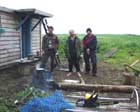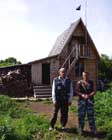
Ranges at the cabin at the
mouth of our river. On nice
days they cook out side.

Rangers at Kurilskoy
Lake cabin.

Kurilskoy rangers with a net
and caviar confiscated from poachers.
(Click on any Image to see a higher resolution version)
We are into the forth week without a storm. Our record span between
storms before this was 12 days. There is no wind, no clouds and bears
are everywhere. There is however, a problem for the fish and hence our
bears around Kambalnoye Lake because the water in the river is now so
low the sockeye salmon who are trying to come here to spawn. They are
holding up in some big pools about ten kilometers down stream and are
waiting for a rain. They seem to know that there are about 100 bears waiting
to pounce on them if they make the run for it in skimpy water.
The good weather also means good flying for me. I have put so many hours
on the Kolb lately that I will soon have to ration myself because of fuel
supply. I only brought four barrels this season and the way the weather
started off I thought it would be about three too many. Four barrels represents
about 8000 kilometers flying. Now with 420 hours (42,000 kilometers) of
flying in southern Kamchatka, I am getting to know the place very well.
Stretched out into a straight line this is more than the distance around
the world at the equator. I drop in on the rangers now and again to see
if they are having any problems. This is a difficult thing we are trying
to do here so I want to make sure that everything runs as smoothly as
possible.
Several years ago, we promised Chico and Biscuit that we would not end
our project here until we were quite sure they would be safe from poachers.
There was lots of evidence of bears being killed in this sanctuary when
we first came here in 1994. Since South Kamchatka Sanctuary (SKS) was
designated a park in 1984, there has been so little money to administer
the place that it was a sanctuary for poachers as well. Ironically, the
hunting area north of here has been better protected as far as overall
numbers of bears killed because Sergey
Poblovsky, the man who owns the hunting concession, makes it very
clear to all that he will shoot on sight anyone he catches poaching. To
look at him you know he is capable of it.
Far north from here in 1994, we talked to several poachers while doing
some research on poaching in the Far East and looking for a place in the
world where we would be allowed to do this study. One poacher described
that he had personally killed 61 bears that spring. He used a snow machine
and an old beat up single shot 12 gage shotgun with hand loaded lead slugs
that he cast himself. When the bears came out of their dens into the snowy
world it was easy to spot them far away, he told us. His technique was
to chase them with his snow machine until they got sick of it and turned
on him. He would quickly stop, wait until they charged up to within eight
meters or less and then shoot them in the head. He said that anyone using
this system who was a bad shot was soon weeded out. When we talked to
him he was heading out for the fall hunt of snaring bears along a salmon
stream. He expected to get another 50. It is very fortunate that the price
of gall bladders has gone down since then but it feels like a precarious
truce to me.
During the past few years, the price of bear gall bladders has gone below
the point where it is lucrative to form an expedition primarily for the
purpose of killing bears. Ironically, this might be a shaky reprieve for
brown bears because last summer China made a big move towards ending the
practice of bear farms where thousands of bears are kept in vile conditions
and milked of their bile by placing catheters into their gall bladders.
This was an important step towards ending a cruel practice but I have
been worried that it might mean bear gall from the wild would become a
more important source once again. Kamchatka is close to China and an easy
market. So far I have seen no sign of this happening.
Salmon caviar is what the poachers are after in South Kamchatka Sanctuary
(SKS). Although, we in North America don't understand what the fuss is
all about regarding salmon eggs (red caviar), it is sold for very high
prices in Japan and in Moscow. Russians like it more than black (sturgeon)
caviar. It is a lucrative enough market to allow poachers to hire helicopters
and go to a wilderness river with a net and procure kegs and kegs of caviar.
On years of high pink salmon runs certain rivers are set aside for legal
fishing for this purpose. Much of it is gathered at processing plants
from salmon caught legally in the ocean.
Caviar poaching becomes a problem for bears because it is worthwhile to
kill them once the poachers are already in the bush, poaching something
else. It is usually done with cable snares and the bears are often left
in the snare alive for days so the stress of being caught by the leg or
neck increases the size of the gall bladder. We located funding from an
individual who is determined to make a difference in the protection for
bears in North America. He was skeptical about funding this plan we had
in Russia but Maureen and I stuck our neck out and insisted that it was
worth the risk of failure. We had been carefully feeling out the possibilities
for several years and had over seen small amounts of our contributors
money being well spent and accounted for. The Preserve administration
has cooperated and shown appreciation for the idea of putting together
a more ambitious ranger program and outfitting them. There are problems
of course, caused from establishing an elitist group who are paid considerably
more than their normal wage of US $25 a month, in one preserve, while
the others limp along as they have been. Our hope is that if it works
well in this one area, we can expand the program later. The only added
bureaucracy we have created is one agent who works for us as sort of an
ombudsmen who heads off problems that might arise, especially when we
are not here. He makes sure the rangers are getting paid and are happy.
We have rangers in three locations:
1. At the mouth of Kambalnoye River in a cabin that we funded to be renovated
three years ago
2. In a cabin near the salmon research station at Kurilskoy Lake
3. At the village of Ozernovskiy, at the mouth of the river originating
from Kurilskoy Lake. This village is on the edge of the South Kamchatka
Sanctuary. I am not allowed to fly into Ozernovskiy because it is a military
town as well as a fishing village (too much red tape), but I do fly along
the boundary of the Sanctuary which roughly follows this Ozernaia River.
The river is the conduit between the Sea of Okhotsk and Kurilskoy Lake,
30 kilometers upstream, birthplace of the most important single-river
salmon fishery in Russia. During the 60 years of research at the station,
they have worked out that if they get two million fish back to the lake
to spawn they will be able to harvest four times that many in the bay
at Ozernovskiy. There is only room in the lake and river system draining
into the lake, for two million to spawn. Too many can cause toxic situations
and less surviving fry. As an indication of how well this seems to be
managed, they have counted 1,900,000 through the weir at the station this
season and there are a few left to come. This is a bit of a fluke -- there
has been a variation of between .4 million and 6 million spawners over
the years. SKS was created to protect both the salmon and the approximately
700 bears who also live there. We came to the Sanctuary because of the
huge number of bears supported by all the food there is for them here.
Because our research required that we live with the bears in a way that
has made them non fearful, we feel an obligation not to leave here until
some form of protection has been established.
So far nothing too troublesome has come up. I have some worries about
the lack of good training here for the rangers. For this reason, we hire
two well trained policemen who also work for two months during the most
troubled time at Kurilskoy Lake.
- Charlie